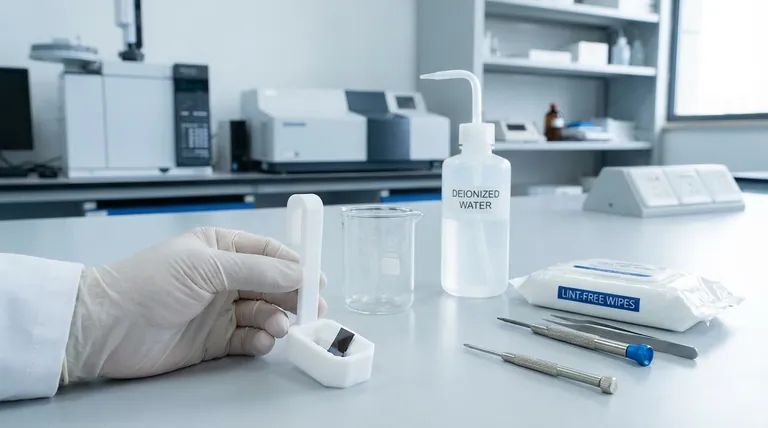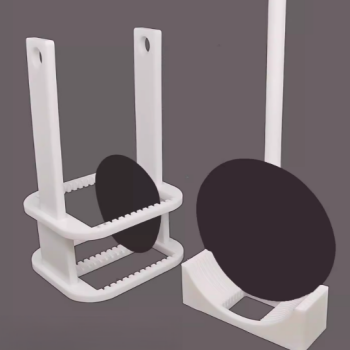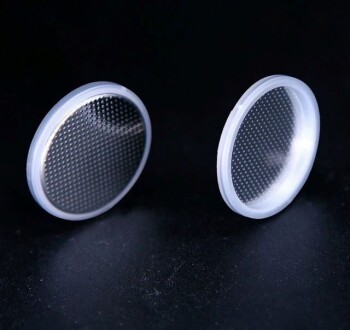Regular checks on an electrode holder fall into three primary categories: mechanical integrity, electrical conductivity, and cleanliness. You must inspect the clamping mechanism for smooth operation, verify all screws and fasteners are secure, check that wire connections are tight, and ensure all conductive surfaces are free of contaminants before each use.
The core purpose of routine electrode holder maintenance is not just to prevent damage, but to guarantee the integrity of your experiment. A compromised holder directly translates to unreliable data, creating a weak link in your entire measurement chain.

1. Mechanical Integrity: Ensuring a Stable Foundation
A secure physical connection is the first requirement for any successful measurement. Mechanical checks ensure the holder can grip the sample or electrode firmly and be positioned accurately without risk of failure.
Inspect the Clamping Mechanism
The primary function of the holder is its grip. Periodically verify that the clip head or clamp opens and closes smoothly and without hesitation. A sticking or loose mechanism can lead to a poor connection or a dropped sample.
Verify All Fasteners
Inspect all fastening components, such as screws, bolts, and adjustment knobs. These parts can loosen over time due to vibration or repeated use. A loose fastener can compromise the holder's stability and electrical connection.
Check the Support Stand and Structure
For holders mounted on a stand, inspect the base to ensure it is stable and free of cracks or deformation. Check that any lifting or sliding supports move smoothly. If a mechanism is stuck, it should be cleaned of debris and lubricated sparingly.
2. Electrical Pathway: Guaranteeing Clean Conduction
A clean, uninterrupted electrical path is non-negotiable for accurate results. These checks focus on removing any barriers between the holder, the electrode, and your instrumentation.
Confirm Secure Wire Connections
Visually inspect and gently tug on the wire connections to the holder. A loose wire is a common source of intermittent signals, high resistance, and noisy data. The connection must be both physically secure and electrically sound.
Maintain Surface Cleanliness
Before every use, ensure the conductive sheet or contact point of the holder is perfectly clean. Contaminants like dust, grease, or residue from previous experiments create an insulating layer that will skew your results.
If the conductive surfaces are dirty, they should be carefully cleaned. Rinsing with deionized water and allowing it to dry is often the recommended procedure.
Understanding the Pitfalls of Neglect
Skipping these simple checks can have significant consequences that undermine your work. Understanding these risks highlights the importance of a consistent maintenance routine.
The Cost of a Poor Connection
A loose mechanical clamp or a dirty electrical contact introduces unwanted resistance and noise into your system. This can lead to erratic readings, non-repeatable results, and hours of wasted time troubleshooting phantom issues in your data.
The Impact of Contamination
Never touch the sample surface or the holder's conductive points with bare hands. Oils and salts from your skin are significant contaminants. Cross-contamination from a dirty holder can invalidate your experiment by introducing unintended variables.
The Risk of Mechanical Failure
A holder that has not been inspected for mechanical integrity poses a direct risk to your equipment. A worn-out clamp can drop and break a delicate or expensive sample, and a loose stand could cause the entire assembly to fall.
Implementing a Practical Maintenance Schedule
To integrate these checks into your workflow, categorize them by frequency.
- Before Every Use: Perform a quick visual check for cleanliness on the conductive surfaces and confirm the clamp grips the sample securely.
- On a Weekly Basis: Conduct a more thorough inspection of all screws and fasteners, verify wire connections are tight, and check the smooth operation of any support stands.
- If You Encounter Issues: If a part is found to be loose, damaged, or malfunctioning, it must be repaired or replaced immediately before any further use.
Ultimately, diligent maintenance of your electrode holder is a direct investment in the quality and reliability of your results.
Summary Table:
| Check Category | Key Actions | Frequency |
|---|---|---|
| Mechanical Integrity | Inspect clamp, verify fasteners, check stand stability | Weekly / Before Use |
| Electrical Pathway | Confirm wire connections, clean conductive surfaces | Before Every Use |
| Cleanliness | Clean with deionized water, avoid skin contact | Before Every Use |
Ensure your lab's data integrity starts with reliable equipment.
KINTEK specializes in high-quality lab equipment and consumables, including durable electrode holders designed for precise, repeatable results. Don't let a faulty holder compromise your experiments.
Contact our experts today to find the perfect holder for your application and keep your measurements accurate.
Visual Guide

Related Products
- Custom PTFE Wafer Holders for Lab and Semiconductor Processing
- Customizable XRD Sample Holders for Diverse Research Applications
- Customizable PTFE Wafer Carriers for Semiconductor and Lab Applications
- Button Battery Case for Battery Lab Applications
- 1400℃ Muffle Oven Furnace for Laboratory
People Also Ask
- What materials are the sample holders made of? Engineered with PTFE and PEEK for Purity
- How can corrosion of the sample holder be prevented when using corrosive chemicals? Protect Your Lab's Integrity
- What are the recommended and prohibited cleaning methods for the PTFE electrode stand? Protect Your Lab Equipment
- How should a PTFE cleaning basket be stored when not in use? Maximize Lifespan & Prevent Contamination
- What is the correct way to place items into a PTFE cleaning basket? Master the Art of Perfect, Repeatable Cleaning














